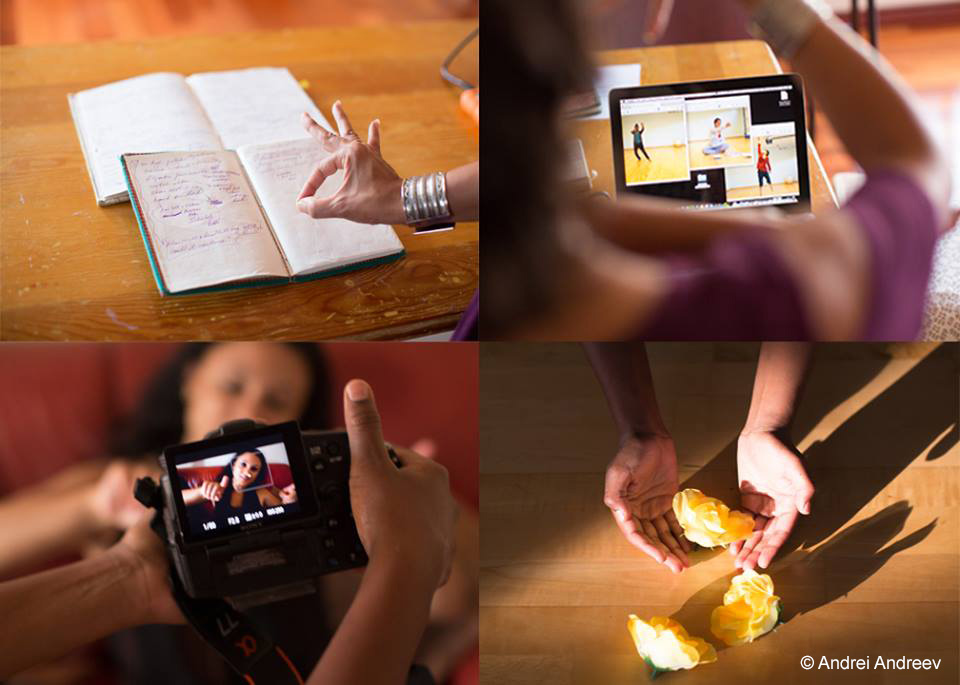“Yes to process!” Constituting a virtual interstitial space via translation and Looping
Challenges for the collective have been our geographic dispersal, the difficulties to raise funding and produce visibility for transnational contemporary choreographic works that engage with non-Euro-American aesthetic and movement forms, the uneven local support structures available to the individual members, as well as cultural and aesthetic differences that are heightened as we consciously engage with our local surroundings and contexts. Our shared and highly structured artistic process, which includes giving each other assignments, posting artistic raw materials on our blog*13 *(13) (which we have called our online open rehearsal studio), giving each other feedback and support, as well as entering into dialogues and disagreements, has facilitated the creation of a shared, in-between space constituted by the individual members’ studies and ideas in dialogue with each other.*14 *(14) It is a space created through and for our transnational negotiations, a space for expanding and testing the limits of ideas and meanings, re-articulating non-essentialized identities and cultural difference.
My notion of an “in-between space” is informed by postcolonial theoretician Homi Bhabha’s theorizations of interstitial and in-between spaces, the “realm of the beyond” (Bhabha 1994: 1), (*1) an “interstitial passage between fixed identifications [that] opens up the possibility of a cultural hybridity that entertains difference without an assumed or imposed hierarchy” (Bhabha 1994: 4).
(*1) an “interstitial passage between fixed identifications [that] opens up the possibility of a cultural hybridity that entertains difference without an assumed or imposed hierarchy” (Bhabha 1994: 4). (*1)
(*1)
Processes of translation (I am conceptualizing translation broadly here, as translation between languages, cultural translation, and translations of artistic methods, approaches and materials, passed down or created within the collective’s long-distance process), I believe, is crucial for establishing the Post Natyam Collective’s in-between space for and through our artistic process and dialogues. We make a conscious effort to negotiate and interweave local contexts and their differences, which get consolidated in the collaborative process via discussion and engagement with each other’s artistic studies. At times, we actively translate each other’s materials, questions, and arguments into the different cultural contexts that collective members operate in. The members are free to develop aspects or elements from the process individually or in small groups into projects/products such as performances, papers, talks, videos, etc., that circulate locally or virtually. Via posting and commenting on our blog, our “local” or small group translations, which spin out from the joint process, are virtually “looped back” into the shared space.
Similar to literature on collective authorship, as well as Derrida’s notion of authorship as Ziemer utilizes it, we have thought about translation in the past as a choreographic approach that is opposed to a notion of choreography as a singular act of innovation. With our emphases on translation and recycling, on the other hand, we are “rewriting the choreographer as translator rather than author” (Chatterjee and Lee 2009: 150). (*9) Translation, therefore, for us, has to do with engagements with and re-contextualizations of received materials and insights, meanings, approaches, concepts that emerge from new connections that are being drawn (cp. Chatterjee and Lee 2009).
(*9) Translation, therefore, for us, has to do with engagements with and re-contextualizations of received materials and insights, meanings, approaches, concepts that emerge from new connections that are being drawn (cp. Chatterjee and Lee 2009). (*9) For Bhabha’s “beyond,” too, translation is crucial. Shaobo Xie summarizes in a review of Bhabha’s The Location of Culture:
(*9) For Bhabha’s “beyond,” too, translation is crucial. Shaobo Xie summarizes in a review of Bhabha’s The Location of Culture:
Living in the interstices of culture and history, he maintains, the subject of cultural differences assumes the status of what Walter Benjamin describes as the element of resistance in the process of translation (224). In translation there are many interstitial points of meaning whose determination is also a violation. In much the same way, the ambivalent migrant culture, the interstitial minority position, ‘dramatizes the activity of culture’s untranslatability’ (224), and therefore reveals the indeterminate temporalities of the in-between. (1996: 162) (*1)*15 *(15)
(*1)*15 *(15)
The notion of an in-between space also resonates with Hannah Arendt’s notion of “Erscheinungsraum“ (space of appearance),*16 *(16) which Irit Rogoff connects to the realm of art in her article on collectivities and mutualities. However, Arendt’s “’Erscheinungsraum’—the spatial in-between in which people appear in front of each other,” is temporal and “does not last beyond the actions in which it started to exist“ (Arendt in Rogoff 2002: 58, my translation), (*15) which is in tension with the permanence that is created by our blog. But, Arendt also argues that through action and speaking, one can create a spatial in-betweenness, that is not tied to a home and can settle anew anywhere in the world (ibid.). This aspect of “Erscheinungsraum,“ I believe, can connect to Post Natyam’s system of creating local “products” out of the shared process, which circulate and temporarily interface local audiences with our transnational process. The challenge here is to undo patterns of presenting and reception that easily relegate transnational and collective dimensions into the background.
(*15) which is in tension with the permanence that is created by our blog. But, Arendt also argues that through action and speaking, one can create a spatial in-betweenness, that is not tied to a home and can settle anew anywhere in the world (ibid.). This aspect of “Erscheinungsraum,“ I believe, can connect to Post Natyam’s system of creating local “products” out of the shared process, which circulate and temporarily interface local audiences with our transnational process. The challenge here is to undo patterns of presenting and reception that easily relegate transnational and collective dimensions into the background.
Sandra Chatterjee ( 2015): Rethinking Collective Artistic Production. In: p/art/icipate – Kultur aktiv gestalten # 06 , https://www.p-art-icipate.net/rethinking-collective-artistic-production/



 Artikel drucken
Artikel drucken